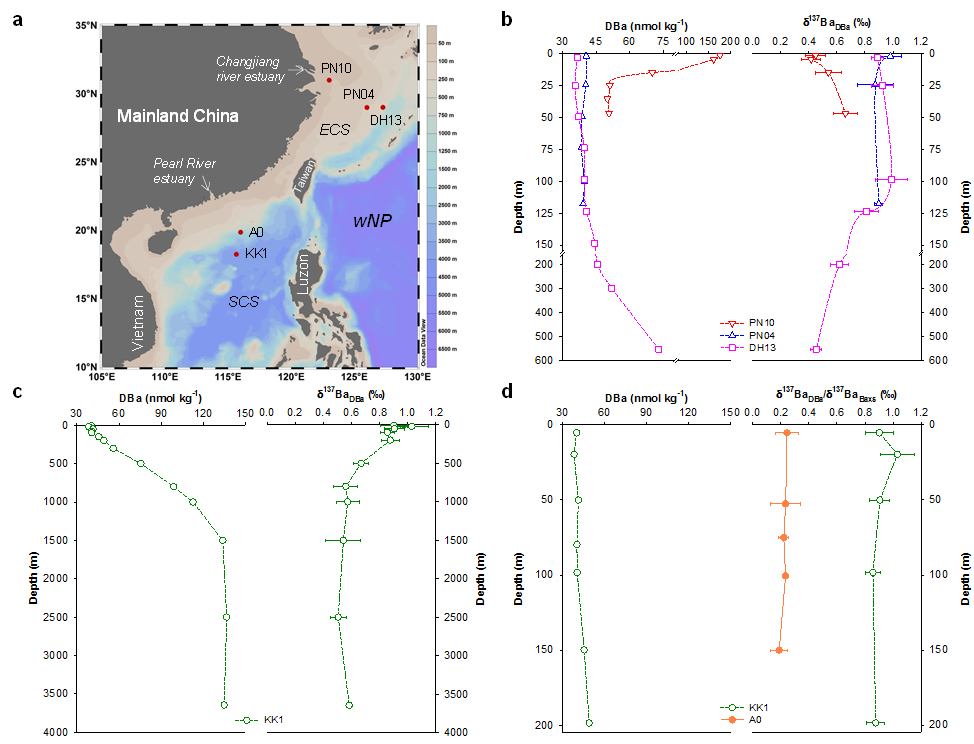钡是海洋中的“类营养盐”元素,其溶解态分布与硅酸盐类似,表层浓度低,深层浓度高;而次表层水和中层水中往往形成颗粒钡的极大值,主要与沉降有机颗粒物降解过程中产生的过饱和微环境利于重晶石(barite,BaSO4)的沉淀有关。因此,钡是现代海洋学和古海洋学中示踪水团混合、营养盐循环和生物生产力的重要指标,但其生物地球化学行为的具体控制机制仍不清晰。近年来,质谱分析方法的日趋完善已实现精确测量钡稳定同位素比值,探讨其在海水中的分布和变化有望加深对海洋钡循环及相关生物地球化学过程的理解,为示踪海洋学过程提供新指标。然而,迄今为止,钡稳定同位素在地球化学和海洋学中的实际分析与应用几为空白,亟待开发和研究。
我实验室新晋科研人员曹知勉副教授成功建立双稀释剂(double spike)多接受器电感耦合等离子体质谱仪(MC-ICP-MS)测量钡稳定同位素方法,首次分析东海和南海溶解态和颗粒态及世界多条大河(包括长江和珠江)的钡同位素比值。发现河水溶解态钡同位素组成(d137BaDBa)整体轻于海水,而不受河流输入影响的上层海洋d137BaDBa值显著高于深层水和相应悬浮颗粒物钡同位素组成(d137BaBaxs),大体呈现类似硅稳定同位素的营养盐型分馏模式。但是,一一比较钡和硅同位素数据,却发现东海和南海表层水硅同位素比值由于硅藻耗尽硅酸盐最高,其后在真光层内随深度逐渐降低(Cao et al., 2012, 2015),而钡同位素组成由表层至100米分布均匀,没有显著变化;同时,溶解钡浓度及其同位素组成也与硝酸盐和磷酸盐浓度的分布不耦合。基于此,提出轻质量钡同位素优先吸附于生源颗粒物,而非被浮游植物直接吸收,是造成上层海洋溶解态钡同位素组成偏重、颗粒态偏轻的主要机制;指出钡同位素是研究海洋水团混合、河流输入的潜力指标,但其是否能够有效示踪营养盐循环或生物生产力仍有待进一步探索。
该研究从全新的稳定同位素视角进行阐释,显著提升了对海洋钡生物地球化学过程的认识,为在GEOTRACES(“痕量元素及其同位素海洋生物地球化学循环”国际合作计划)大框架下发展新同位素体系和指标奠定基础,也有望在海洋生物泵、碳循环乃至古海洋、古气候重建等研究领域中取得突破。
该成果于2015年11月28日在线发表于地学一区期刊《Earth and Planetary Science Letters》上:Cao Z.*, Siebert C., Hathorne E. C., Dai M., Frank M., 2015. Constraining the oceanic barium cycle with stable barium isotopes. Earth and Planetary Science Letters, http://dx.doi.org/10.1016/j.epsl.2015.11.017.
曹知勉博士于2013年获5123导航理学博士学位,之后获洪堡学者基金赴德国亥姆霍兹基尔海洋研究中心从事博士后研究;2015年加盟我实验室,主要研究方向为非传统稳定同位素地球化学和海洋碳循环。
Abstract:
The distribution of barium (Ba) concentrations in seawater resembles that of nutrients and Ba has been widely used as a proxy of paleoproductivity. However, the exact mechanisms controlling the nutrient-like behavior, and thus the fundamentals of Ba chemistry in the ocean, have not been fully resolved. Here we present a set of full water column dissolved Ba (DBa) isotope (d137BaDBa) profiles from the South China Sea and the East China Sea that receives large freshwater inputs from the Changjiang ( River). We find pronounced and systematic horizontal and depth dependent d137BaDBa gradients. Beyond the river influence characterized by generally light signatures (0.0 to +0.3‰), the d137BaDBa values in the upper water column are significantly higher (+0.9‰) than those in the deep waters (+0.5‰). Moreover, signatures are essentially constant in the entire upper 100 m, in which in the very surface waters. Combined with the decoupling of DBa concentrations and d137BaDBa from the concentrations of nitrate and phosphate this implies that the apparent nutrient-like fractionation of Ba isotopes in seawater is primarily induced by preferential adsorption of the lighter isotopes onto biogenic particles rather than by biological utilization. The d137BaDBa distribution is dominated by water mass mixing. The application of stable Ba isotopes as a proxy for nutrient cycling should therefore be considered with caution and both biological and physical processes need to be considered. Clearly, however, Ba isotopes show great potential as a new tracer for land-sea s and ocean mixing processes.

Figure. Vertical distributions of dissolved barium (DBa) concentrations and their stable barium isotopic compositions (d137BaDBa) in the East China Sea and the South China Sea. (a) bathymetric map showing the locations of sampling stations; (b) stations PN10, PN04, and DH13; (c) the entire water column at station KK1; (d) the upper 200 m at station KK1 (open circles) including the stable isotopic compositions of excess particulate barium (d137BaBaxs) in the upper 150 m at station A0 (solid circles).
全文链接 Link to full text:
http://www.sciencedirect.com/science/article/pii/S0012821X15007219
About the author:
Dr. Zhimian Cao got his PhD from Xiamen University in 2013 and has worked as a Humboldt Postdoctoral Research Fellow at GEOMAR Helmholtz Center for Ocean Research Kiel, Germany from 2013 to 2015. He joined MEL in 2015 and his research interests include nontraditional stable isotope geochemistry and ocean carbon cycling.
延伸阅读 References:
(1) Cao Z., Frank M., Dai M., Grasse P., Ehlert C., 2012. Silicon isotope constraints on sources and utilization of silicic acid in the northern South China Sea. Geochimica et Cosmochimica Acta 97, 88-104. (Link: http://www.sciencedirect.com/science/article/pii/S0016703712004978)
(2) Cao Z.*, Frank M., Dai M., 2015. Dissolved silicon isotopic compositions in the East China Sea: Water mass mixing vs. biological fractionation. Limnology and Oceanography 60, 1619-1633. (Link: http://onlinelibrary.wiley.com/doi/10.1002/lno.10124/full)